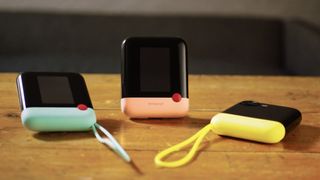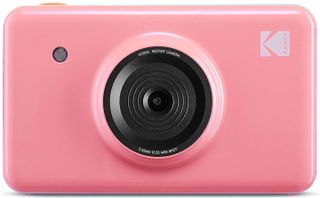Polaroid Pop vs Kodak Mini Shot: Which should you buy?


Our pick
The Polaroid Pop packs in a lot of megapixels, is capable of HD video recording, and supports microSD cards up to 128GB. It also has different white balance settings, a flash and timer, and you can be selective of what gets printed. However, the camera itself is a bit large and the glossy plastic tends to get scratched easily.
For
- 20MP and 1080p/720p HD video recording
- Supports microSD
- Connects to smartphone
- Large prints
- Includes flash and timer
Against
- Large and bulky design
- Prints are somewhat low resolution
- No sticky-backed option for Zink paper
- Glossy plastic easy to scratch and scuff up
- High price tag

Value pick
Kodak Mini Shot is a decent option when it comes to instant cameras, thanks to the 10MP sensor, flash, auto-focus capability, as well as exposure, white balance, and gamma correction. You can even connect it to your smartphone via the companion app and use it as a printer for your Camera Roll images, which is nice. However, the cartridges it uses are harder to find than the Fujifilm Instax or Polaroid Zink options out there.
For
- Highly affordable
- Small and compact
- Auto-focus, exposure, and white balance correction
- Connects to smartphone via Bluetooth
- Prints are credit card size
Against
- No storage capability
- Only 10MP
- Can't record video
- Hard to find print cartridges
Polaroid and Kodak are both pretty big names in the world of retro instant camera photography. The Polaroid Pop and Kodak Mini Shot are some of the latest offerings, and while they're both good, they're designed for different people.
Let's break it down

The Polaroid Pop may appear more expensive at first, but it's relatively easy to find the paper for it, so you'll always be able to maintain a constant supply. While the Kodak Mini Shot appears cheaper at first glance, you'll have to keep in mind that it will be harder to find the correct paper that it uses, since it's not as common as Polaroid, Fujifilm, or some of the other instant cameras out there.
| Header Cell - Column 0 | Polaroid Pop | Kodak Mini Shot |
|---|---|---|
| Cost | $200 | $100 |
| Dimensions | 6 x 4 x 1 in | 0.9 x 3 x 5.2 in |
| Profile | Large, bulky round square | Slim and compact |
| Power | Rechargeable via microUSB, lasts around 50 prints | Rechargeable via microUSB, 620mAh capacity |
| Connects to phone | Yes via Wi-Fi | Yes via Bluetooth |
| Compatible app | Yes | Yes |
| Digital copies | Yes on microSD up to 128GB | No |
| Megapixels | 20MP | 10MP |
| Video recording | Yes, 1080p/720p HD | No |
| Screen | Yes, touch | Yes, LCD |
| Built-in photo editing | Yes | No, only through app |
| Shooting tools | 7 white balance options, flash, timer | Auto-focus, flash, exposure, white balance, and gamma correction |
| Close-up shots | Yes, digital zoom | No |
| Prints | Polaroid ZINK Paper | Kodak Mini 2 Photo Paper Cartridge MC |
Even though the Kodak Mini Shot is more affordable, we still prefer the Polaroid Pop because it's more flexible.
With the Polaroid Pop, you get a mighty 20MP sensor that is also capable of recording video in stunning 1080p or 720p HD quality, and it even lets you make animated GIFs. Everything gets stored on an optional microUSB (up to 128GB), so you'll always have a digital backup of your memories.
Even though the Kodak Mini Shot is more affordable, we still prefer the Polaroid Pop because it's more flexible.
The large touchscreen makes it easy to see what the viewfinder sees, as well as make any edits that are necessary. Plus, you can review each photo before printing, so you can be selective and not waste any paper.
The Polaroid Pop app is needed to connect your Polaroid Pop to your smartphone via Wi-Fi, and you can send your smartphone photos to the Pop to edit and print out. There are even fun effects and stickers that you can put on your photos, and there's the ability to draw and write on them too. The Pop also prints out images on 3.5-by-4.25-inch ZINK paper, so they're large sheets, though the printed resolution leaves a bit to be desired. There's also no stick-backed option, so you can't turn photos into stickers.
However, if you're on a budget right now but still want to enter the instant camera foray, then the Kodak Mini Shot is a decent option. It's half the price of the Polaroid Pop, though it does come with significantly fewer features. Still, it's not bad for what it is since you get 10MP, auto-focus, exposure, white balance, and gamma correction, and it's a good photo printer for your smartphone images. The only drawback is that finding the correct paper is a bit more difficult than for the competition, because we only found the Kodak Mini 2 Photo Paper Cartridge at Amazon, and no major box retailers carry it. If Amazon is out of stock, then you won't be able to stock up until they're back, and who knows how long that takes.
Master your iPhone in minutes
iMore offers spot-on advice and guidance from our team of experts, with decades of Apple device experience to lean on. Learn more with iMore!
If you don't mind the cost of it, we recommend the Polaroid Pop over the Kodak Mini Shot. It may be double the price, but you get a ton more useful features, and finding paper for it won't be very hard.

It does it all
Polaroid Pop packs in a 20MP sensor and can record 1080p/720p HD video. You can review everything before printing so nothing's wasted, and editing is done right on the camera's touch screen. You can connect it to the Polaroid Pop app to send photos from your phone to the Pop to edit and print.

Less money, fewer features
If you're on a budget, Kodak Mini Shot is a decent option. It has a 10MP sensor, auto-focus, exposure, white balance, and gamma correction, and an auto flash. The LCD screen lets you see the viewfinder easily, and make quick adjustments. However, finding the correct paper for this camera might be difficult.
Christine Romero-Chan was formerly a Senior Editor for iMore. She has been writing about technology, specifically Apple, for over a decade at a variety of websites. She is currently part of the Digital Trends team, and has been using Apple’s smartphone since the original iPhone back in 2007. While her main speciality is the iPhone, she also covers Apple Watch, iPad, and Mac when needed. When she isn’t writing about Apple, Christine can often be found at Disneyland in Anaheim, California, as she is a passholder and obsessed with all things Disney, especially Star Wars. Christine also enjoys coffee, food, photography, mechanical keyboards, and spending as much time with her new daughter as possible.
Most Popular






